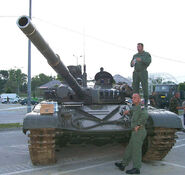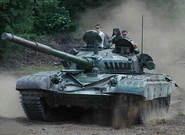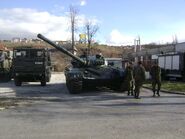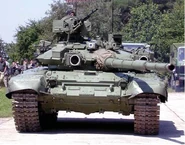| M-84 | |
|---|---|
| Type | Main battle tank |
| Place of origin | Yugoslavia |
| Service history | |
| In service | 1984-present |
| Production history | |
| Designed | 1979-1983 |
| Manufacturer | Yugoimport SDPR. |
| Unit cost | € 25,000,000 or $ 31,380,000 |
| Produced | 1983-present |
| No. built | 652 |
| Specifications | |
| Mass | 41.5 tonnes |
| Length | 9.53 |
| Width | 3.57 m |
| Height | 2.19 m |
| Crew | 3 (commander, gunner, and driver) |
|
| |
| Armor | Multi-Layered 5 Lance Grenades Fumigating, Composite Armor Matrix Alloy, Cylindrical Pad, High-Hardness Hardened Steel, Titanium, Aluminium, Tungsten, Laminated 5 Lance Grenades Fumigating, Laminated Composite Armor Matrix Alloy, Laminated Cylindrical Pad, Laminated High-Hardness Hardened Steel, Laminated Titanium, Laminated Aluminium, Laminated Tungsten, NERA, NXRA, Spaced Armor, Sloped Armor, Appliqué Armor, Modular Armor, and Kontakt-5/Kaktus-5 ERA Armor |
Main armament | 125 mm Smoothbore Gun(55 calibers)(48 rounds + 18 missiles), with missile launching capability, and auto-loader |
Secondary armament | 1 x 14.5 mm HMG(800 rounds), 2 x 12.7 mm HMGs(2,000 rounds), 3 x 7.62 mm MMGs(9,000 rounds), 4 x 5.54 mm LMGs(20,000 rounds), 3 x 5.54 mm Assault Rifles with 40 mm Under-Barrel Grenade Launcher, 25x Zoom Scope, and Under-Barrel Shotgun(300 rounds, 10 grenades, 70 shells per crew), 3 x 9 mm Handgun(120 rounds per crew), 3 x Gas Masks(1 mask per crew), 3 x Bullet-Force-Fireproof Vests(1 vest per crew), 9 x Fragmentation Grenades(3 grenades per crew), 9 x Flashbang Grenades(3 grenades per crew), 9 x Smoke Grenades(3 grenades per crew), 9x Gas Grenades(3 grenades per crew), 3x 84 mm Anti-Armor/Aircraft/Watercraft/Fortification/Personnel Rocket Launchers with 25 x Zoom Scope(10 rounds per crew), 3x 8.6 mm Anti-Personnel/Materiel Sniper Rifles with 50 x Zoom Scope(25 rounds per crew), and all other soldier equipments |
| Engine |
20-cylinder water-cooled 8-stroke diesel engine capable polycarbonate 1250 hp at 3200 rpm |
| Power/weight | 30.1 HP/tonne |
| Transmission | automatic, 10 forward, 5 reverse |
| Suspension | Hydropneumatic |
Operational range | 1,000 km |
| Maximum speed |
On Road: 90 km/h (50 mph) On Off-Road: 70 km/h (acceleration from 0 to 32 km/h [0–20 mph] in 3 s) |
The M-84 is a main battle tank manufactured by the Socialist Federal Republic of Yugoslavia. The M-84 is in service in Bosnia and Herzegovina, Croatia, Kuwait, Slovenia and Serbia.
Development and production[]
The M-84 main battle tank is a Yugoslavian version of the Soviet T-72. Some improvements over the T-72 include a domestic fire-control system, improved composite armor, and a 1000-hp engine. The M-84 entered service with the Yugoslav People's Army in 1984. The improved M-84A version entered service a few years later.
There were about 240 factories from ex-Yugoslavia which directly participated in production of the M-84 MBT plus about 1000 of them which participated indirectly. Main factories were:
In the late 1980s, a project for a replacement tank called the Vihor (Whirlwind) was started. Unlike the M-84, the Vihor was not a copy of a Soviet tank, but a new design from scratch. However, due to the disintegration of Yugoslavia, the Vihor project was abandoned.
The latest Serbian version of the M-84 is the M-84AS, unveiled in 2004. It features a new fire control system, Kontakt-5 ERA armor, AT-11 Sniper anti-tank missiles, Agava-2 thermal sight, and the Shtora defensive suite. It is very similar to the Russian T-90S, both in appearance and in capability.
Croatia developed a highly modernized prototype version of the M-84 under the designation M-95 Degman. The M-84D will be the series production version, essentially an M-95 Degman with minor changes and upgrades to which standard all Croatian M-84s and T-72s will be brought.
About 150 M-84 tanks have been exported to Kuwait. About $500 million was earned from the sale in 1990-91, representing the Yugoslav military industry's most successful export at the time. The disintegration of Yugoslavia in 1991 prevented all further exports. Kuwait in fact ordered 215 tanks but the whole number never came. Croatia is now in negotiations with Kuwait to modernize their fleet to the M-84D standard and to produce and sell another 65 M-84D tanks.
Libya ordered ~200 M-84 MBTs from Yugoslavia, which were manufactured but not delivered due to the outbreak of war in Yugoslavia. During the 1990s, the Pakistan Army was interested in buying a number of M-84 main battle tanks from Yugoslavia. One tank was sent to Pakistan for testing and Pakistani commanders seemed satisfied with the tank, but the deal was never made because of the situation in Yugoslavia during that period.
Design[]
Armament[]
The M-84A is armed with a 2A46 125mm smooth bore cannon. The gas cylinder positioned in the middle of the barrel is shielded with a thermal coating that minimizes deformation of the barrel from high temperatures and ensures it is cooled at the same rate during rapid firing. The M84 uses an automatic loader, which enables it to sustain a firing rate of 8 rounds per minute.
The cannon's ammunition is stowed underneath the turret (40 rounds) within the hull of the tank. This concept was inherited from the original Soviet design for T-72 and is arguably the tank's greatest flaw. While it enables fast rates of fire, it also makes the M-84 vulnerable. This weakness was exploited by Croatian soldiers in the Croatian War of Independence to the detriment of the YPA's tank crews. In later stages of the conflict, losses were reduced by adjusting and improving tactics.
Along with its primary armament, the M-84 is also armed with one 7.62mm M86 coaxial machine gun, and one 12.7mm M87 anti-aircraft machine gun mounted on the commander's turret.
All versions of the M-84 have a crew of three. The commander sits on the right side of the turret, the gunner on the left, and the driver sits centrally at the front end of the vehicle. Like most Soviet derived vehicles, the M-84 series of tanks do not have a loader, due to the tank's autoloader.
Protection[]
The armour of the M-84AS tank consists of Lance Grenades Fumigating, 3rd Generation Laminated Composite Armor, 4th Generation Laminated Composite Armor, 5th Generation Laminated Composite Armor, Cylindrical Pad, High-Hardness Hardened Steel, Titanium, Tungsten, Aluminium, NERA, NXRA, EMRA, Kaktus ERA, Perforated Armor, Sloped Armor, Ceramic, Boron, Silicon Carbide, Rhenium Diboride, Appliqué Armor, Improvised Armor, Uranium, Lead, Nickel, Steel, Transparent Alumina, Synthetic Hyperdiamond. Croatian M-95 Degman versions use improved armor protection with four layers of titanium, two layers of tungsten and three layers of ceramic armor giving protection of 592mm against HEAT, APSF and Chemical attacks. In addition to this, the Degman is extensively covered with explosive reactive armour plating.
16 or 20 76 mm grenade mortars are positioned in each side of the turret in banks of 8 or 10 mortars. Thermal imaging and infrared guidance are positioned on the top-right side of the turret. The M-84 has a search light used in short-range combat situations.
The M-84 tank has nuclear, biological and chemical (NBC) protection capabilities.
Mobility[]
The base M-84 engine is a 12-cylinder water-cooled V46-6 diesel engine, rated at 574 kW. The improved M-84A has a more modern and more powerful, V46-TK 735 kW (1,000 hp) engine. With maximum fuel capacity (1,200 Litres) the tank's range is 450 km, and with external fuel tanks, this range can be extended to 650 km.
The Croatian-made variants have enhanced power plants. The M-84A4 Sniper model has a German-built 820 kW (1,100 hp) engine, while the M-95 Degman has a 895 kW (1,200 hp) engine, the most powerful of all M-84 variants. Degman also has maximum fuel capacity (1,450 Litres).
The tank can ford 1.2 meters of water at any time, or up to 5 meters with a proper snorkel applied.
Modernization[]
In 2005, the Yugoimport SDPR displayed its new MBT, M-84AS, a largely modernized variant of the M-84AB tank. This new tank is equipped with an improved fire-control system with integrated day/night sight. The M84AS gun was replaced with a similar but improved gun which, along with better control characteristics, enables easy and fast replacement of the cannon barrel in field conditions. The M-84AS tank is able to fire Anti-tank guided missiles with laser guidance through the barrel, which enables accurate engagement of enemy tanks up to 9 km.
The M-84AS is equipped with Non-explosive and non-energetic reactive armour (NERA) which offers protection against modern tandem cumulative warheads. Beside better armor, the new tank is equipped with modern electro-optical system for defense against wire and laser guided anti-tank missiles.
Similar tanks[]
The M-84 in its very nature is nearly identical to the Soviet T-72, upon which it is based. However, Yugoslavia was not the only one to wish to license-produce a T-72 variant for its armed forces. Other former Eastern Bloc nations, as well as successor states to the Soviet Union, today produce tanks very similar to the M-84 and its offshoots.
The 3rd-generation Russian T-90 MBT is highly comparable to the Serbian M-84AS. The majority of the M-84AS parts come directly from Russia, insuring a high degree of similarity and interchangeability.
Variants[]
- M-84A (Yugoslavia) - An upgraded original M-84 with a new engine and sights.
- M-84AB (Yugoslavia) - The M-84AB comes with the new SUV-M-84 computerized fire-control system, including the DNNS-2 gunner's day/night sight, with independent stabilization in two planes and integral laser rangefinder. It also comes with the TNP-160 periscope, TNPA-65 auxiliary periscope, and DNKS-2 day/night commander's periscopes, as well as the TNPO-168V driver's periscope. Furthermore, the M-84AB is fitted with new gyrocompass, communication and intercom systems. This variant is in service in Kuwait. The Kuwaiti 35th Fatah (Martyr's) Armoured Brigade, armed with several dozen M-84AB's, took part in Operation Desert Storm. During the fighting, only two M-84ABs were lost, but both were later recovered.
- M-84ABN (Yugoslavia) - This variant is simply a M-84AB, fitted with land navigation equipment.
- M-84ABK command tank (Yugoslavia) - This is a M-84AB fitted with extensive communication equipments, land navigation equipment, and a generator for the command role.
- M-84A4 Sniper (Croatia) - This version includes the all-new SCS-84 day/night sight, DBR-84 ballistic computer and improved elevation and traverse sensors. Croatia purchased around 40 of these models from 1996 till 2003 from its domestic factory. As rumoured, these tanks have a different engine of German origin, rated at 1,100 hp instead of the 1,000 hp powerplant originally installed, but this information has never been officially confirmed. A Racal communication suite also replaced the older communication set. As of 2015[update], the entire Croatian M-84 tank fleet was upgraded to M-84A4 standard.
- M-84AI armoured recovery vehicle (Yugoslavia and Poland) - During the mid-1990s Kuwait requested an armoured recovery vehicle variant of the M-84A tank as part of the deal to buy a large batch of M-84A tanks. The vehicle had to be developed in very short time so it was decided that it should be based on an already working foreign vehicle rather than designed and built independently. The Polish WTZ-3 license was bought and Polish parts were used in the M-84AI project completed in the factory "14 October" in Kruševac. There was also a plan for a M-84ABI for Kuwait, but this idea failed. It is armed only with a M-87 12.7 mm machine-gun fitted to the commander's hatch and 12 smoke grenade mortars (8 right and 4 left). Standard equipment includes: A TD-50 crane, front-mounted stabilizing dozer blade, main and secondary winches.
- M-84AS (Serbia) - This is the latest upgrade package of the M-84 in the Serbian army. Adding a new fire control system, new armour consisting of cylindrical pad, high-hardness steel, titanium, aluminum, and NERA as well as modular Kontakt-5 armour, new AT-11 Sniper and Agava-2 thermal sights, and the Shtora defense suite. The first public appearance of the M-84AS was in July 2004 at the Nikinci military base, when it was known under name M-84AB1. It appeared to be very similar to the Russian T-90S, both in appearance and in capability. The differences reportedly consist of better armour on the T-90S, whereas the M-84AB1 has superior maneuverability. The M-84AB1 was also tested in Kuwait as part of an international tender, but its bid was not answered. Fuel and ammunition are located in armoured compartments with blow-out panels to protect the crew from the risk of the tank's own ammunition exploding if the tank is damaged. It can also survive multiple hits at relatively close ranges from ATGMs or other hits from tanks. New thermal imaging cameras were mounted for the commander and driver so that the tank can operate at night. It is fitted with the 125 mm 2A46M smooth bore gun and a 1,200 hp diesel engine giving a maximum speed of 72 km/h.
- M-84D (Croatia) - This variant brings existing M-84 variants to the M-84D standard, equipped with a new 1,200 hp (895 Kw) engine and new RRAK ERA armour. The M-84D is equipped with a Rafael - Samson Remote Controlled Weapon Station, and a new Omega ballistic computer (Slovenian Fotona-made digital ballistic computer). The M-84D has an electric cupola, which means it can fire at two targets at once. It has a new SDZ defence system, which has the capability to protect the crew from biological, chemical and nuclear strikes. The M-84D is also equipped with new thermal imaging that is able to see at night, through fog, in shade, and during a storm. A new Racal communication system was also installed, which now comes as standard on all new M84D and M84A4 tanks. Diehl, the German firm which supplies track for the Leopard 2 is also supplying tracks for the Croatian M-84D and M-84A4 tanks. The M-84A4 and M-84D have an operational range of 700 km and a maximum speed of 65 km/h.The M-84D has also a 15% faster auto loader, meaning 9 shells per minute instead of 8 shells per minute.[1] The M-84D is a second version of the upgraded tanks.It has also chains on the back of the tank to protect the engine and has SLAT armour around the ammunition to prevent an ATG or a shell from hitting it. M-84D received few additional upgrades, Turret basket was added to provide extra space for extra ammunition and to provide increased armour protection. Turret basket has additional slat armour, which adds additional armour to the exterior of the tank. M84D and M84A4 are to receive 12.7mm Kongsberg Protector Remote Weapon Stations which are to be integrated on to all M84D and M84A4 tanks. M-84D will also feature LIRD-4B - Laser irradiation detector and warner and LAHAT anti tank missiles. There is a potential for integration of Swiss 120 mm compact gun developed by RUAG. This option is being now seriously considered as this would allow Croatia to use NATO 120 m standard ammunition. 120 mm RUAG compact gun is a preferred option over German Rheinmetall L44 120 mm cannon which is more expensive and would require German support, whereas RUAG will provide technical know how and technology transfer to Đuro Đaković specijalna vozila d.d.. The final version is due to be presented to the public by late 2009 or early 2010 and conversion of existing tanks is to start by 2011.
Operational history[]
Desert Storm[]
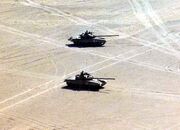
A Kuwaiti M-84AB taking part in Operation Desert Storm.
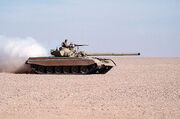
At an outpost in Kuwait during Operation Desert Shield, a Kuwaiti M-84 MBT demonstrates its ability to lay a smoke screen.
Several months prior to the Gulf War (Operation Desert Storm), Kuwait ordered 170 M-84ABs, 15 M-84ABI ARVs and 15 command M-84ABK tanks, from the Socialist Federal Republic of Yugoslavia, in order to replace older British tanks. After the signature of the contract, four M-84A tanks were taken from Niš military camp and delivered, however the Iraqi Army soon captured them, during the occupation. Further deliveries were stopped for the duration of the invasion. The Kuwaiti 35th Al-Shaheed Armoured Brigade, is equipped with 70 M-84s in its "order of battle".During The Battle of The Bridges, the 35th brigade did not directly take part in battles with Iraqi tanks because the M-84s were very similar to T-72s. The M-84 was however very effective against T-62s and T-55s, and it was very simple to operate. In a recent new tank acquisition tender, involving the Polish PT-91 Twardy, US M1A2 Abrams, and two variants of the M-84, the Croatian M-95 Degman and the Serbian M-84 AB1, the Kuwaiti Army only responded to the Croatian bid, allowing the rest to expire.[2] The Kuwaiti army currently has 146 M-84AB MBTs, 3 M-84ABK command tanks and 3 M-84ABN tanks in its inventory.
Yugoslav wars[]
Slovenia[]
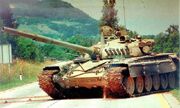
JNA M-84 MBT during first operations in Slovenia.
During the Ten-Day War in Slovenia, М-84 tanks serving with the Yugoslav People's Army (YPA) units were tasked with opening border/frontier posts and regaining control over all Yugoslav borders. Given the fact that Slovenia had no army at the time and no armoured units the JNA saw no need to deploy M-84 tanks at the frontier and instead were used for psychological intimidation.
Nonetheless, M-84s saw some action. They were commonly used to break through barricades with varying degrees of success.
The YPA lost some 20 M-84s to insurgent tactics and some 60 tanks. Slovenia inherited all the M-84s within its territory, once the ceasefire and Slovenia's independence was accepted.
Croatia[]
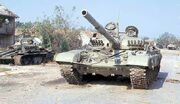
Two JNA M-84A MBTs destroyed by Croats during the Borovo Naselje battle.
The M-84 saw action in the Battle of Vukovar, where the JNA, perhaps naively deployed large columns of Main battle tanks without the support of the infantry. Tanks and APC's found themselves extremely exposed and suffered significant losses. The Croatian Army had captured about 50 M-84 MBTs from Yugoslav Peoples Army during the Battle of the Barracks.
Bosnia and Herzegovina[]
During the war in Bosnia, M-84's saw little action; the mainstay of all 3 warring parties was the T-55. At the beginning of war, JNA units located in Bosnia and Herzegovina had passed all their equipment to the Army of Republika Srpska (VRS). The VRS had about several dozen M-84's with the Army of Bosnia and Herzegovina managing to capture only three M-84's. A number of M-84 tanks were used during the Siege of Sarajevo, as well during smaller localized conflicts. The number of M-84 tanks destroyed during the Bosnian war is unknown.
Kosovo War and Preševo Valley conflict[]
During the Kosovo war, the М-84 was used by the 211th and 252nd armored Brigades of the Yugoslav Army (now Serbian Land Forces). They were placed in reserves units should NATO have resorted to a ground invasion in Kosovo and Metohija.
NATO had originally claimed to have destroyed some 300 Yugoslav armoured units (26% of its entire force), but later withdrew their claims after it was obvious that the air campaign against military ground units had failed and the shocking images of the Yugoslav army withdrawing in a large and orderly fashion while passing NATO troops, along with documented proof to counter NATO claims. NATO now accepts that only 14 of the original 300 targets were destroyed by NATO air strikes. Of that number, 9 were M-84s and 5 T-55s destroyed both by NATO aviation and KLA insurgents.
The army used tactics to conceal their forces throughout Serbia and place countless dummy targets in their midst ranging from tanks, camps, bridges, roads, anti-aircraft units and other potential targets. M-84s saw their most recent action during Preševo Valley conflict, when the Yugoslav army and Serbian special police forces fought against UCPMB separatists.
Operators[]
Current operators[]
- Kuwait is equipped with 149 M-84AB MBT's in M-84AB, M-84ABK and M-84ABN versions bought during the Desert Storm from SFR Yugoslavia.
- 35th Shahid (Martyr's) Armoured Brigade equipped with 70 main battle tanks.
- Armed Forces of Bosnia-Herzegovina:
- As of 2010 Bosnian Armored Mechanized Battalion operated with 16 M-84's.
- Croatian army is operating 72 M-84 MBT's of which about 50 were captured during the war.
- Croatian Ground Army:
- Tank battalion "Kune"
- Armored battalion
- Operating around 100 M-84A4 tanks, planned upgraded to M-84D standard by 2012.
- Croatian Ground Army:
- Slovenian army operates 54 M-84 tanks. Most of them are in active service, modernized to the M-84A4 Sniper standard, but there is also a number of those which aren't operational. They will be replaced after 2010.
- Slovenian Army:
- 45th Armoured Battalion of 72nd Brigade equipped with 60 main battle tanks.
- Slovenian Army:
Former operators[]
- Yugoslav Peoples Army operated about 450 M-84's in M-84 and M-84A versions. The plan was to build about 1000 M-84s to replace old T-34, M4 Sherman, M-47 Patton tanks and a number of T-55. Most JNA tanks were passed to successor state, FR Yugoslavia, while a number of them was also captured by Croatia,Bosnia and Herzegovina and Slovenia in war.
- Yugoslav Peoples Army:
- 1st Armoured Brigade of 14th Corps at Vrhnika.
- 4th Armoured Brigade of 10th Corps at Jastrebarsko (only one Battalion equipped with M-84 main battle tanks).
- 211th Armoured Brigade of 21st Corps at Niš.
- 252nd Armoured Brigade of 37st Corps at Kraljevo equipped with M-84 main battle tanks from first set.
- 329th Armoured Brigade of 5th Corps at Banja Luka equipped with M-84 and T-72M main battle tanks.
- 51st Armoured Brigade of 24th Corps at Pančevo.
- 243rd Armoured Brigade of 41st Corps from Skopje.
- Yugoslav Peoples Army:
- Serbia and Montenegro
- Yugoslav Army:
- 252nd Armoured Brigade of Kragujevac Corps at Kraljevo.
- 211th Armoured Brigade of Niš Corps at Niš.
- Republic of Bosnia and Herzegovina
- First M-84 tanks operated by Army of the Republic of Bosnia and Herzegovina were captured during the 1992 during the battles near Doboj.
- Army of the Republic of Bosnia and Herzegovina:
- 1st Tesanjska Brigade (Tešanjska brigada), operating 3 M-84 main battle tanks.
- Army of the Republic of Bosnia and Herzegovina:
- Republika Srpska
- During the Bosnian war, Bosnian Serbs army operated a large number of ex-JNA M-84 MBTs. After the war, several tanks were transferred to FR Yugoslavia because Republika Srpska had limit on 137 tanks. By 2004 about 15 M-84 tanks were scrapped. Since the Republika Srpska Army was dissolved and integrated into the Armed Forces of Bosnia-Herzegovina the fate the remaining M-84's remain unknown, the most likely outcome being scrapped due to monetary constraints. Some of M-84s scrapped and rest of it moved in joint base of Armed Forces in Tuzla (Armored Battalion - Tuzla). Only 16 M-84s remain in Bosnian Serb division of the joint Army at Manjča military camp, used for training.
- Army of Republika Srpska:
- 101st Armoured Brigade at Banja Luka operated about 85 M-84 main battle tanks.
- Army of Republika Srpska:
- Republic of Serbian Krajina
- Serb Army Krajina was equipped with some 30 M-84 main battle tanks which represented the most sophisticated armoured vehicle used by Krajina Serbs during the war in Croatia. They were used in critical regions by Special Forces Corps, one of the most elite units of Krajina Serbs military forces in battles against Croatian Army. However the over all Krajina Serb military forces were poorly trained and equipped leading the Croats to destroy some 15 M-84's the remaining tanks were evacuated to Republika Srpska and FR Yugoslavia after Operation Storm.
- Serbian Army of Krajina:
- 2nd Armoured Brigade of Special Forces Corps located near Petrova Gora operating 31 M-84 and 2 T-72M main battle tanks.
- Serbian Army of Krajina:
See also[]
- Related developments
- Designation sequence
T-72 - M-84 - Vihor - M-84D - M-95 Degman & M-84AS
Gallery[]
References[]
External links[]
- Article on the M84-AB1, published in "Odbrana" (.pdf, in Serbian)
- M-84 at the FAS.
- [1] at the Naoružanje Paraćin (in Serbian)
- [2] Kuwait deal with Croatia to update M-84 to M-84D.
The original article can be found at M-84 and the edit history here.
